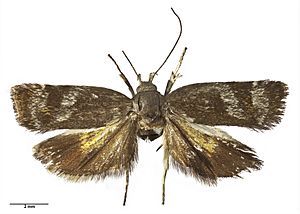Hierodoris bilineata facts for kids
Quick facts for kids Hierodoris bilineata |
|
|---|---|
 |
|
| Holotype specimen | |
| Scientific classification | |
| Kingdom: | |
| Phylum: | |
| Class: | |
| Order: | |
| Family: |
Oecophoridae
|
| Genus: | |
| Species: |
H. bilineata
|
| Binomial name | |
| Hierodoris bilineata (Salmon, 1948)
|
|
| Synonyms | |
|
|
Hierodoris bilineata is a special kind of moth that lives only in New Zealand. It belongs to a group of moths called Oecophoridae. The New Zealand Department of Conservation says this moth is "At Risk, Naturally Uncommon." This means it's not found in many places and needs protection. Scientists think this moth might give birth to live young, which is unusual for moths that usually lay eggs.
Contents
Discovering the Hierodoris bilineata Moth
This moth was first described in 1948 by a scientist named John Tenison Salmon. He studied moths collected from kanuka trees on Great Island. This island is part of the Three Kings Islands. The moths were found by E. G. Turbot.
At first, the moth was named Heliostibes bilineata. Later, in 1988, another scientist, John S. Dugdale, moved it to the Hierodoris group of moths. The original moth specimen used to describe the species is kept at the Auckland War Memorial Museum. This special specimen is called a holotype.
What the Hierodoris bilineata Moth Looks Like
The Hierodoris bilineata moth is about 15 millimeters (a little over half an inch) wide when its wings are spread. Its front wings are dark brown. They have two cloudy black spots. There are also two broad, whitish lines across the wings. These lines might join together to look like a "U" shape. The wings also have tiny whitish scales that give them a shiny, bronze look.
The back wings are dark brown too. Their edges are white near the body and turn orange-yellow towards the middle. The moth's head and body are dark brown. Its belly has bright orange stripes. Its legs, antennae, and mouthparts are dark brown with whitish scales.
You can tell this moth apart from other Hierodoris moths because its antennae are plain. It also doesn't have a shiny, metallic look on its body. Plus, it's smaller than other similar moths in its group.
Where the Hierodoris bilineata Moth Lives
This moth is endemic to New Zealand. This means it's found nowhere else in the world. It probably lives only on the Three Kings Islands. It has been found on Great Island and South West Island, both part of the Three Kings Islands.
Life and Reproduction of the Moth
Scientists don't know much about how this moth lives. However, something very interesting was found. When a female moth was studied, a larva (a young moth) was found inside her body. This suggests that Hierodoris bilineata might give birth to live young. Most moths lay eggs, so this would be quite unusual! Adult moths have been seen flying in April and May.
Moth's Food and Home
We don't yet know what the larvae of this moth eat. But it seems like the moth is connected to a plant called Kunzea ericoides, also known as kanuka. This plant might be where the moth lives or where its larvae feed.
Protecting the Hierodoris bilineata Moth
The Hierodoris bilineata moth is listed as "At Risk, Naturally Uncommon" under the New Zealand Threat Classification System. This means it's not very common in nature. It needs to be protected so it can continue to thrive in New Zealand.

